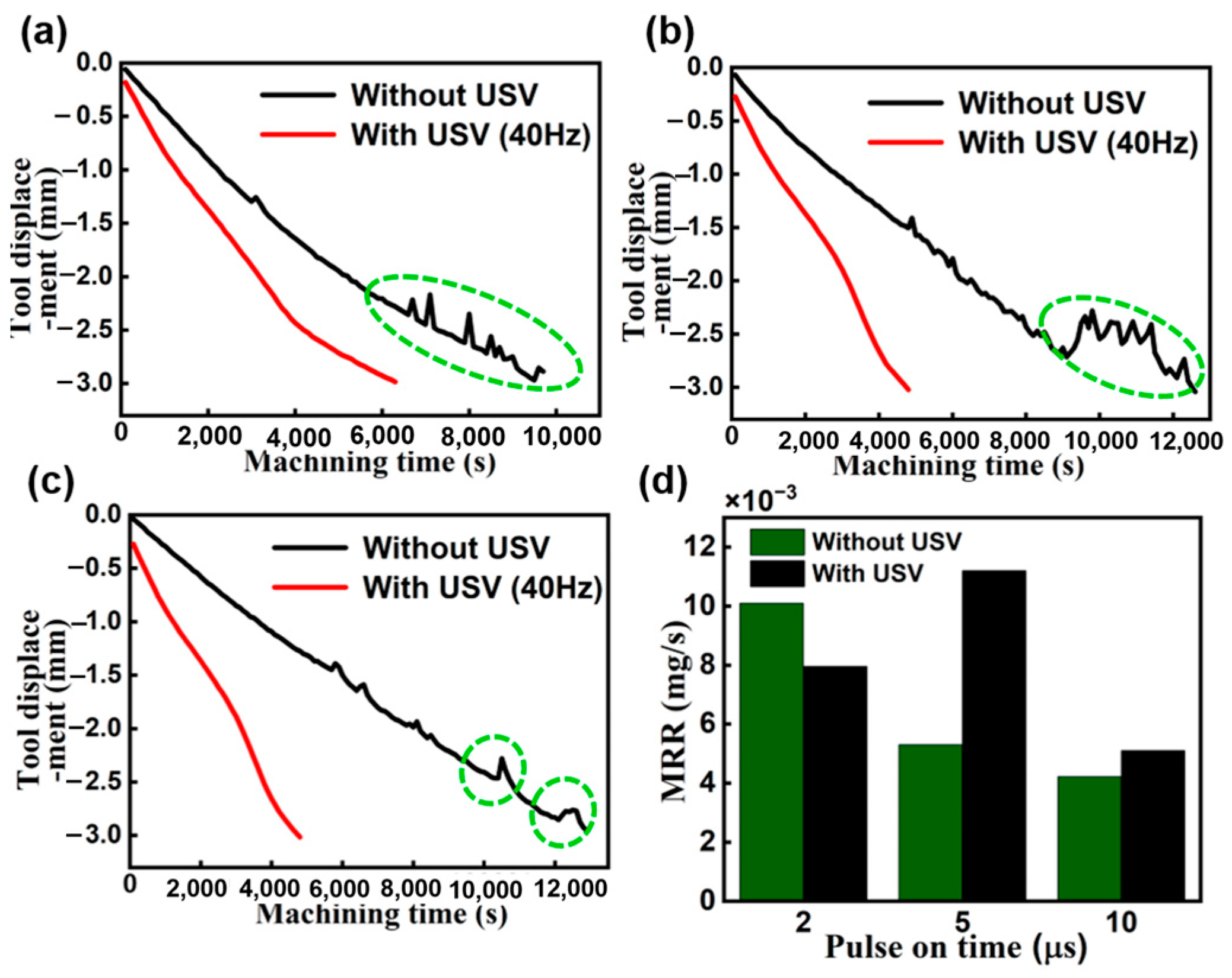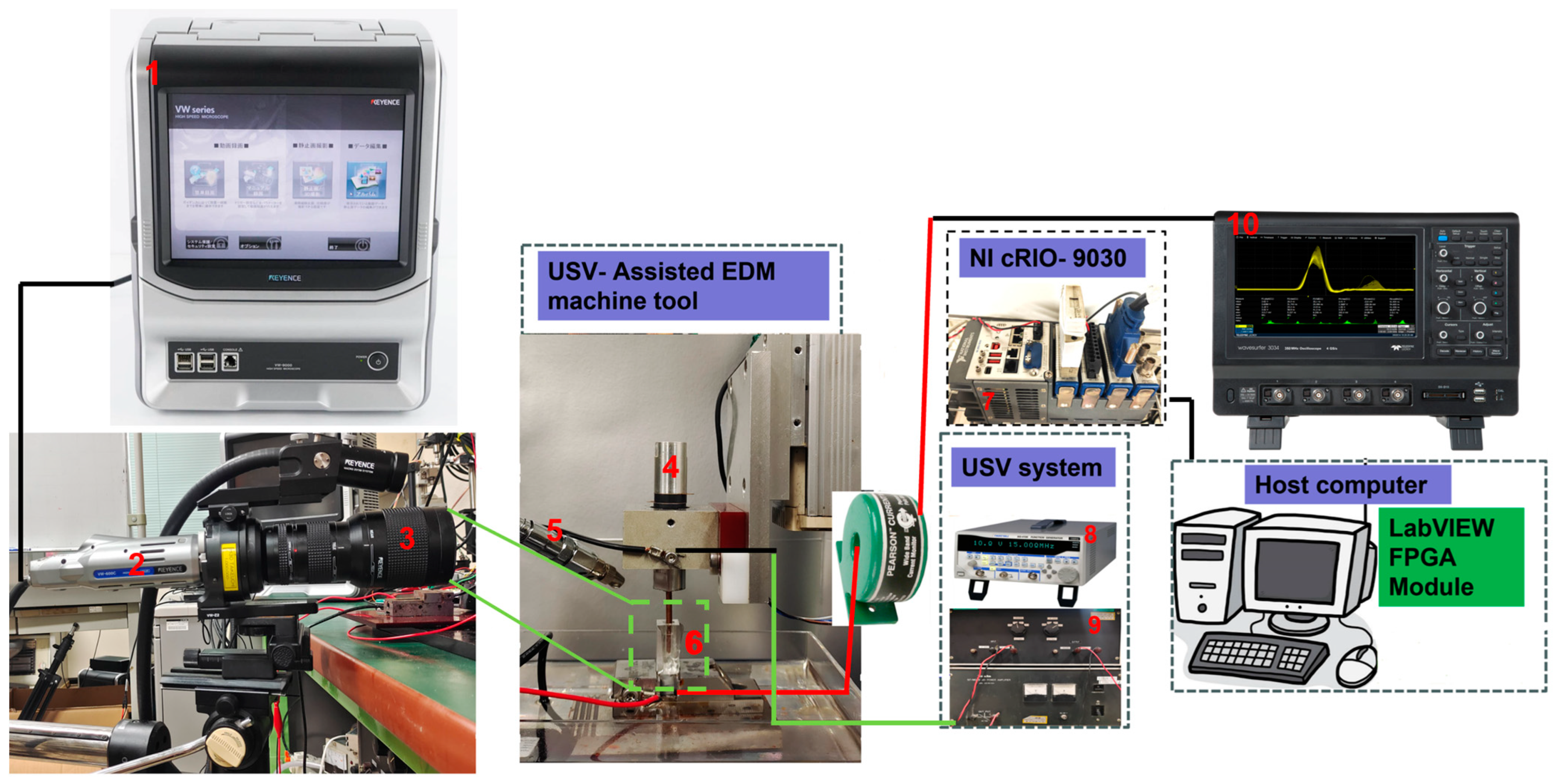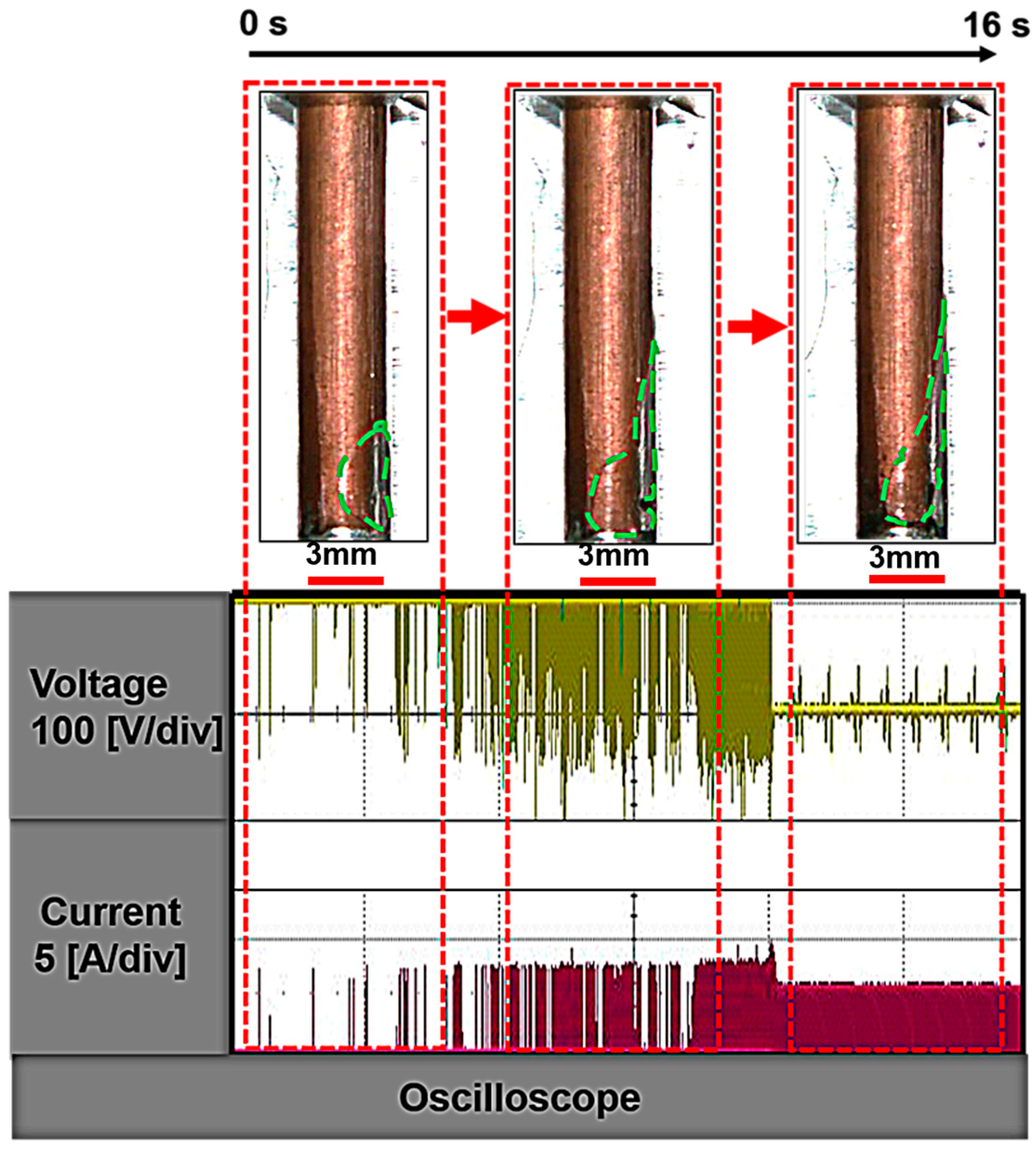In Situ Observation of Bubbles and the Effect of Ultrasonic Vibration on Bubble Behavior in EDM
Abstract
:1. Introduction
2. In Situ Observations of Bubble Behavior in EDM
2.1. Experimental Method and Observation Equipment
2.2. Elucidation of the Interelectrode Discharge Condition Determined by Bubbles
2.3. Depth-Dependent Bubble Behavior in EDM
3. Effect of Ultrasonic Vibration on the Bubble Behavior in USV-Assisted EDM
3.1. Finite Element Simulation of the Ultrasonic Vibration System
3.2. CFD Simulation of Interelectrode Fluid Flow with Ultrasonic Vibration
3.2.1. Principle of the Ultrasonic Flow Field
3.2.2. Selection of the Simulation Model
3.2.3. Dynamic Mesh Establishing and Parameter Settings for Gap Flow Field Calculation
3.2.4. Analysis of the Simulated Flow Field
4. Bubble Behaviors in the High-Aspect-Ratio Hole Ultrasonic Vibration-Assisted EDM
5. Conclusions
- (1)
- As machining depth increases, it increasingly challenging for bubbles to exit the interelectrode gap, leading to the predominant occupation of the side gap by bubbles.
- (2)
- Observation results indicate that debris freely distributes along the liquid–gas boundary, with its removal primarily dependent on the driving force exerted by bubbles.
- (3)
- CFD results indicate that periodic variations in flow pressure and velocity induce turbulence, potentially positively impacting the exclusion of bubbles and discharge of debris in deep-hole EDM.
- (4)
- In USV-assisted EDM of holes with an aspect ratio of 5, bubbles consistently fragment and coalesce toward the hole outlet. In contrast, without ultrasonic vibration in EDM for holes with smaller aspect ratios, bubbles tend to stagnate and oscillate within the interelectrode gap without further progression.
- (5)
- As the depth-to-diameter ratio of the machining hole exceeds 5, the expulsion of machining bubbles and debris solely relying on the pumping and cavitation effects induced by the ultrasonic vibration at the electrode tip are insufficient. Therefore, future research will emphasize the investigation of multimodal vibration of the electrode to enhance the performance of USV-assisted EDM.
Author Contributions
Funding
Institutional Review Board Statement
Informed Consent Statement
Data Availability Statement
Acknowledgments
Conflicts of Interest
References
- Li, G.; Natsu, W.; Yang, J.; Yu, Z. Bubble flushing effect in micro EDM drilling and its relation with debris. J. Mater. Process. Technol. 2022, 305, 117590. [Google Scholar] [CrossRef]
- Rajurkar, K.P.; Levy, G.; Malshe, A.; Sundaram, M.M.; McGeough, J.; Hu, X.; Resnick, R.; DeSilva, A. Micro and nano machining by electro-physical and chemical processes. CIRP Ann.-Manuf. Technol. 2006, 55, 643–666. [Google Scholar] [CrossRef]
- Gao, C.S.; Liu, Z.X. A study of ultrasonically aided micro-electrical-discharge machining by the application of workpiece vibration. J. Mater. Process. Techol. 2003, 139, 226–228. [Google Scholar] [CrossRef]
- Chern, G.L.; Wu, Y.J.E.; Liu, S.F. Development of a micro-punching machine and study on the influence of vibration machining in micro-EDM. J. Mater. Process. Techol. 2006, 180, 102–109. [Google Scholar] [CrossRef]
- Wang, J.; Han, F.Z.; Cheng, G.; Zhao, F.L. Debris and bubble movements during electrical discharge machining. Int. J. Mach. Tools Manuf. 2012, 58, 11–18. [Google Scholar] [CrossRef]
- Li, G.D.; Natsu, W.; Yu, Z.Y. Elucidation of the mechanism of the deteriorating interelectrode environment in micro EDM drilling. Int. J. Mach. Tools Manuf. 2021, 167, 103747. [Google Scholar] [CrossRef]
- Ichikawa, T.; Natsu, W. Investigation of Machining Characteristics of Micro-EDM with Ultrasonically Vibrated Machining Fluid under Ultra-small Discharge Energy. Int. J. Electr. Mach. 2013, 18, 1–7. [Google Scholar] [CrossRef]
- Xing, Q.X.; Yao, Z.Y.; Zhang, Q.H. Effects of processing parameters on processing performances of ultrasonic vibration-assisted micro-EDM. Int. J. Adv. Manuf. Technol. 2021, 112, 71–86. [Google Scholar] [CrossRef]
- Abdullah, A.; Shabgard, M.R.; Ivanov, A. Effect of ultrasonic-assisted EDM on the surface integrity of cemented tungsten carbide (WC-Co). Int. J. Adv. Manuf. Techol. 2009, 41, 268–280. [Google Scholar] [CrossRef]
- Ferraris, E.; Castiglioni, V.; Ceyssens, F.; Annoni, M.; Lauwers, B.; Reynaerts, D. EDM drilling of ultra-high aspect ratio micro holes with insulated tools. CIRP Ann.-Manuf. Technol. 2013, 62, 191–194. [Google Scholar] [CrossRef]
- Hung, J.C.; Lin, J.K.; Yan, B.H.; Liu, H.S.; Ho, P.H. Using a helical micro-tool in micro-EDM combined with ultrasonic vibration for micro-hole machining. J. Micromech. Microeng. 2006, 16, 2705–2713. [Google Scholar] [CrossRef]
- Kumar, R.; Singh, I. A modified electrode design for improving process performance of electric discharge drilling. J. Mater. Process. Techol. 2019, 264, 211–219. [Google Scholar] [CrossRef]
- Kunieda, M.; Kitamura, T. Observation of Difference of EDM Gap Phenomena in Water and Oil Using Transparent Electrode. Procedia CIRP 2018, 68, 342–346. [Google Scholar] [CrossRef]
- Shervani-Tabar, M.T.; Abdullah, A.; Shabgard, M.R. Numerical study on the dynamics of an electrical discharge generated bubble in EDM. Eng. Anal. Bound. Elem. 2006, 30, 503–514. [Google Scholar] [CrossRef]
- Shervani-Tabar, M.T.; Abdullah, A.; Shabgard, M.R. Numerical and experimental study on the effect of vibration of the tool in ultrasonic assisted EDM. Int. J. Adv. Manuf. Techol. 2007, 32, 719–731. [Google Scholar] [CrossRef]
- Shervani-Tabar, M.T.; Seyed-Sadjadi, M.H.; Shabgard, M.R. Numerical study on the splitting of a vapor bubble in the ultrasonic assisted EDM process with the curved tool and workpiece. Ultrasonics 2013, 53, 203–210. [Google Scholar] [CrossRef] [PubMed]
- Xu, J.; Huanhuan, R. Design and finite element simulation of an ultrasonic transducer of two piezoelectric discs. J. Meas. Eng. 2017, 5, 266–272. [Google Scholar] [CrossRef]
- Wang, J.; Han, F. Simulation model of debris and bubble movement in consecutive-pulse discharge of electrical discharge machining. Int. J. Mach. Tools Manuf. 2014, 77, 56–65. [Google Scholar] [CrossRef]
- Minin, I.V.; Minin, I.V.; Minin, I.V.; Minin, O.V. Computational Fluid Dynamics Technologies and Applications; IntechOpen: Rijeka, Croatia, 2011. [Google Scholar]
- Shaheed, R.; Mohammadian, A.; Kheirkhah, G.H. A comparison of standard k–ε and realizable k–ε turbulence models in curved and confluent channels. Environ. Fluid Mech. 2019, 19, 543–568. [Google Scholar] [CrossRef]
- Dolmaire, A.; Goutier, S.; Vardelle, M.; Geffroy, P.M.; Joulia, A. Investigations on Particle Behavior at the Stagnation Zone for a Suspension Particle Jet in Plasma Spray Conditions. J. Therm. Spray Technol. 2021, 30, 1001–1014. [Google Scholar] [CrossRef]
- Luo, B.; Yan, Q.S.; Pan, J.S.; Lu, J.B.; Fu, Y.Z. Simulation and experimental research on magnetorheological finishing under dynamic pressure with a gap-varying. J. Manuf. Process. 2022, 82, 265–276. [Google Scholar] [CrossRef]
- Tang, J.G.; Yan, C.Q.; Sun, L.C. Enhanced vapor bubble condensation and collapse with ultrasonic vibration. Exp. Therm. Fluid. Sci. 2016, 70, 115–124. [Google Scholar] [CrossRef]
- Brennen, C.E. Cavitation and Bubble Dynamics; Cambridge University Press: New York, NY, USA, 2014; pp. 59–64. [Google Scholar]










Disclaimer/Publisher’s Note: The statements, opinions and data contained in all publications are solely those of the individual author(s) and contributor(s) and not of MDPI and/or the editor(s). MDPI and/or the editor(s) disclaim responsibility for any injury to people or property resulting from any ideas, methods, instructions or products referred to in the content. |
© 2023 by the authors. Licensee MDPI, Basel, Switzerland. This article is an open access article distributed under the terms and conditions of the Creative Commons Attribution (CC BY) license (https://creativecommons.org/licenses/by/4.0/).
Share and Cite
Wang, C.; Sasaki, T.; Hirao, A. In Situ Observation of Bubbles and the Effect of Ultrasonic Vibration on Bubble Behavior in EDM. Materials 2023, 16, 6676. https://doi.org/10.3390/ma16206676
Wang C, Sasaki T, Hirao A. In Situ Observation of Bubbles and the Effect of Ultrasonic Vibration on Bubble Behavior in EDM. Materials. 2023; 16(20):6676. https://doi.org/10.3390/ma16206676
Chicago/Turabian StyleWang, Chenxue, Tomohiro Sasaki, and Atsutoshi Hirao. 2023. "In Situ Observation of Bubbles and the Effect of Ultrasonic Vibration on Bubble Behavior in EDM" Materials 16, no. 20: 6676. https://doi.org/10.3390/ma16206676



